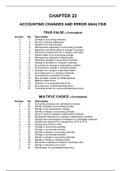Antwoorden
Test Bank CHAPTER 22 ACCOUNTING CHANGES AND ERROR ANALYSIS
- Vak
- Instelling
CHAPTER 22 ACCOUNTING CHANGES AND ERROR ANALYSIS TRUE-FALSE—Conceptual Answer No. Description F 1. Change in accounting estimate. T 2. Errors in financial statements. F 3. Adoption of a new principle. T 4. Retrospective application of accounting principle. F 5. Reporting cumulative effect ...
[Meer zien]




